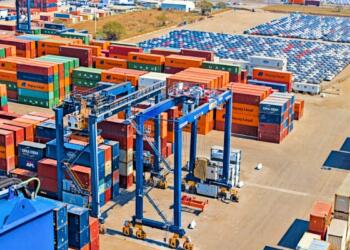
The Laredo border port is one of the fundamental pillars of trade between Mexico and the United States, consolidating itself as the land port with the highest volume of commercial exchange in North America, due to its strategic location on the border between Texas and Tamaulipas, although on the Mexican side it also connects with Nuevo León,which positions it as an essential logistics node for global supply chains.
This port not only facilitates 60% of trade between Texas and Mexico , but is also responsible for nearly 40% of total trade between Mexico and the United States , handling products ranging from industrial manufactures to consumer goods.
According to data from the United States Customs and Border Protection Office (CBP) , Laredo processes between 15,000 and 20,000 truck crossings daily, representing an annual commercial value of more than 300 billion dollars.
Alma L. Saldaña Cruz, Marketing Manager of Port Laredo , highlighted in an interview that these numbers underline the relevance of the border port not only for the regional economy, but for the economic integration of North America.
“Commerce in Port Laredo not only connects two countries, it connects industries and communities in a unique model of economic interdependence,” he said.
The Laredo border port has a robust infrastructure that includes four international bridges : the World Trade Bridge, the Colombia-Solidaridad Bridge, the Juárez-Lincoln Bridge and the Bridge of the Americas. Of these, the World Trade Bridge is the main one for cargo transportation, equipped with multiple lanes and advanced technological systems that allow for streamlined vehicular flow.
Technological innovations include dynamic scales that weigh trucks in motion, reducing waiting times without compromising accuracy.
High and low radiation X-ray inspection systems are also used , which eliminate the need for manual inspections in many cases, optimizing safety and efficiency.
Additionally, Port Laredo has more than 53 million square feet of warehouse space spread across nearly 60 industrial parks , facilitating the handling and distribution of goods.
On the other hand, its airport, with 24/7 operations, complements the needs of air trade, offering dual cargo inspection for exports to Mexico and other international markets.
The adoption of cutting-edge technologies is not only limited to physical infrastructure, but also to operational processes.
The FAST ( Free and Secure Trade ) program , part of the CTPAT initiative, allows certified companies to cross more quickly by ensuring high security standards in their supply chains.
Jerry Maldonado, president of the Laredo Motor Carrier Association (LMCA) , told T21 that Port Laredo is an innovation laboratory for the United States government.
“New technologies are tested here before being implemented elsewhere, because the volume of traffic allows us to identify problems and solutions quickly,” he explained.
Port Laredo is in a strategic expansion phase to meet the demands of projected commercial growth.
According to Maldonado, cargo volume will increase by an average of 5% to 7% annually over the next five years.
To respond to this growth, significant investments are being made in infrastructure, such as the expansion of the World Trade Bridge , which will increase its capacity by 1,500 daily crossings.
This project, which includes environmental studies and urban planning, is expected to be completed in December 2027.
Additionally, new access roads are being developed to ease traffic congestion in Laredo’s urban areas and facilitate more efficient flow to the international bridges.
Economic and social impact
The impact of Port Laredo goes beyond the economic, as the port generates thousands of direct and indirect jobs in the region , strengthening sectors such as transportation, logistics and commerce.
According to research from the Texas A&M Transportation Institute , each day of delay at the border crossing can cost businesses millions of dollars due to the cumulative impact on supply chains.
“Efficiency in Port Laredo is not just a benefit for carriers, it is an economic driver that affects the entire region,” Maldonado said.
Port Laredo is not only an example of logistics efficiency, but also a model of long-term strategic planning, and investments in technology, infrastructure and security programs reflect a commitment to remain competitive in an ever-evolving business environment.
“The port is vital to North America’s trade and economy. Our challenge is to anticipate the future, investing today in solutions that will allow us to continue leading tomorrow,” said Maldonado.
Comment and follow us on X: @GrupoT21















